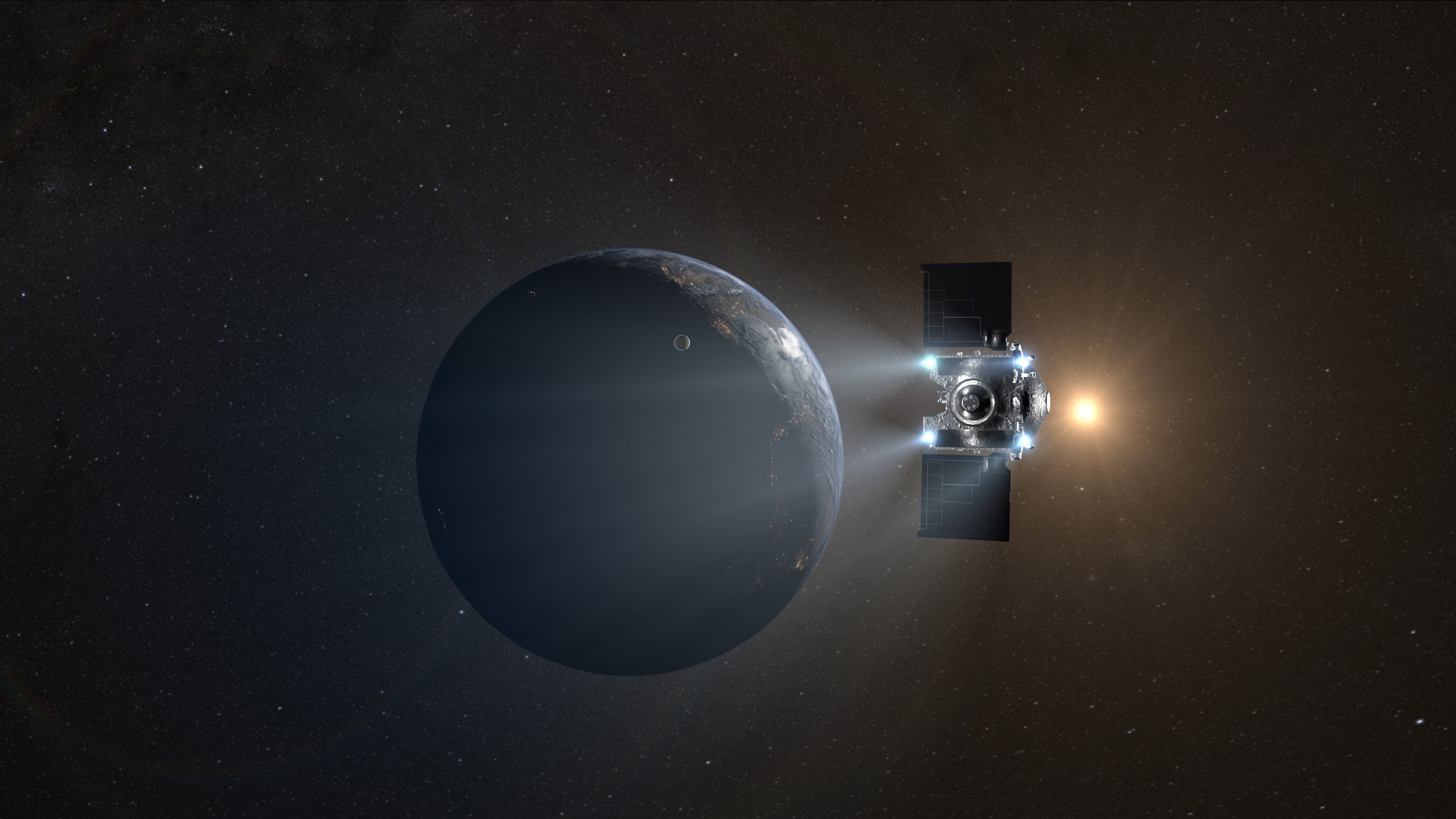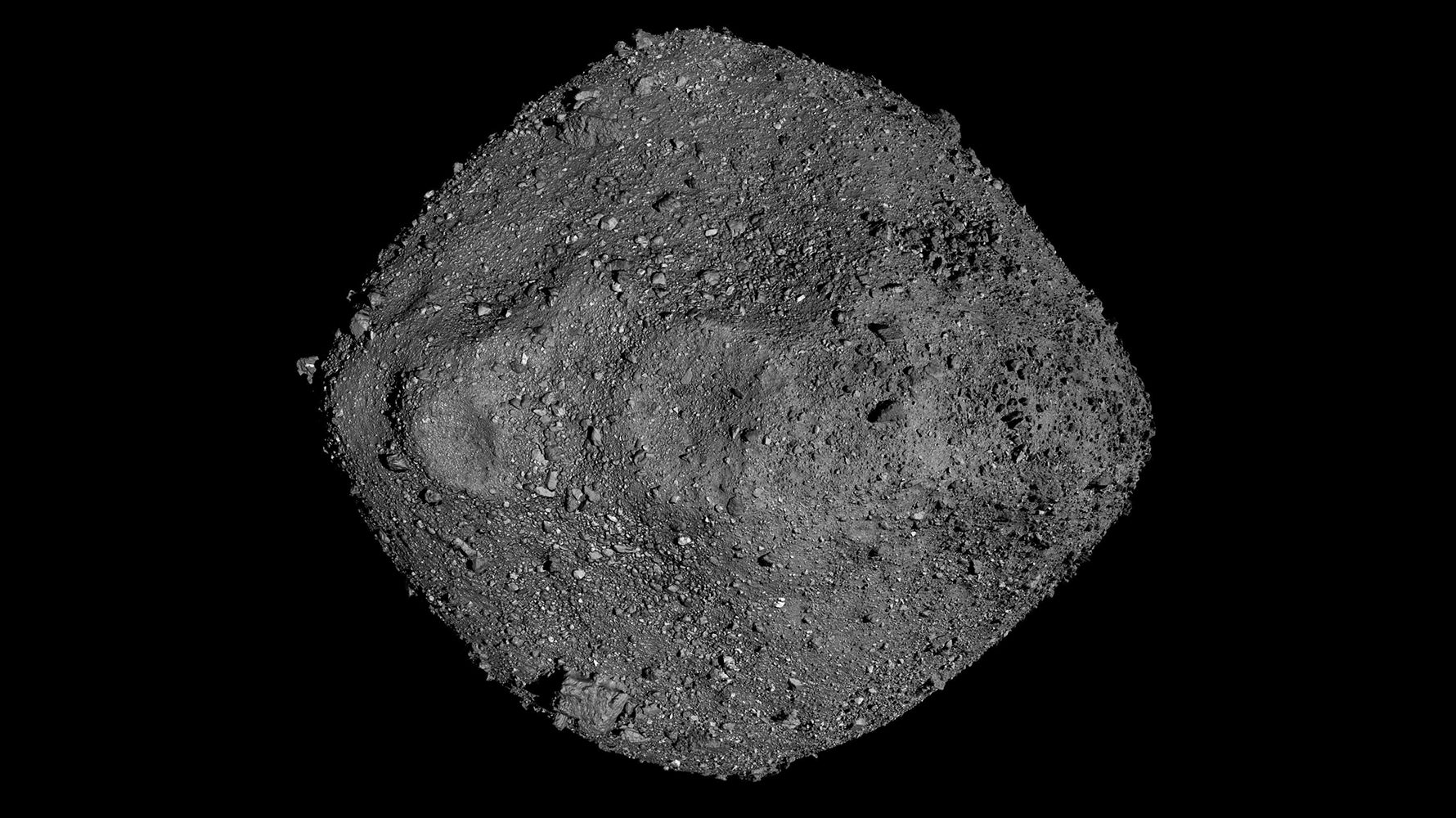
Update: On Sept. 24, OSIRIS-REx’s sample return capsule separated from its parent craft and reentered the atmosphere, touching down in the Utah desert. NASA retrieved the samples and secured them in a clean room, marking a successful end to OSIRIS-REx primary mission.
Imagine arriving back at Earth after traveling through space for seven years, tirelessly transmitting images and hauling back rock samples from the diamond-shaped asteroid 101955 Bennu. Time for vacation, right? Hardly for intrepid OSIRIS-REx.
This Sunday, Sept. 24, the craft’s primary mission will culminate when it swings by Earth and drops off the largest set of samples to ever be returned from an asteroid. The pristine rocks will be a scientific boon, a window into the early solar system that could provide key clues to the origins of water and life on Earth.
But as soon as the spacecraft leaves Earth’s vicinity, it will begin an extended mission to examine a second asteroid, 99942 Apophis. The new mission promises to be a blockbuster follow-up that sheds light on one of the most menacing asteroids near Earth’s orbit. In fact, Apophis will pass only 20,000 miles (32,000 kilometers) from Earth’s surface on April 13, 2029 — closer than most geosynchronous satellites, nearly 10 times closer than the Moon, and visible to the naked eye for observers in the Eastern Hemisphere.
Although the OSIRIS craft will not be able to return any samples from Apophis, it will still be able to deploy its full arsenal of observational instruments during this close encounter, giving scientists key information on what may be necessary to one day spare Earth from an incoming asteroid.
Mission to Bennu

The OSIRIS-REx mission launched from Cape Canaveral on Sept. 8, 2016 towards Bennu. The probe performed an Earth flyby in September 2017, which is a key maneuver that allows it to reach nearby asteroids while preserving propellant. Finally, on Dec. 3, 2018, the explorer reached Bennu, revealing the dark asteroid to be a dusty and rock-covered world with a diameter nearly 1,600 ft (490 m), almost as wide as the Empire State Building is tall.
OSIRIS-REx spent the next 20 months characterizing Bennu. The asteroid didn’t disappoint and turned out to be a fascinating world.
For one, it is a carbon rich environment with water and possible amino acids — the building blocks for life on Earth. Lab analysis will confirm whether amino acids exist on Bennu after samples are delivered.
ORISIS-REx also discovering that Bennu is ejecting particles into space, expelling pebbles and dust from its surface. This is a danger to nearby spacecraft. Sensors can become smudged, leading to poor images; solar arrays can be pitted and clouded, failing to generate power; and navigational star-sensors can be tainted, disorienting the probe.

As for the structure of Bennu itself, it is a porous orb, representing a collection of small rocks and boulders thrown together with dust tossed in. While astronomical images taken from afar may suggest Bennu is a solid rock, in fact it is loosely packed, with 20 to 40 percent of its volume being empty space. If a person stepped onto Bennu, they might sink into the surface as if stepping into a child’s play pit of plastic balls, the team reported in research published in July 2022.
OSIRIS-REx also discovered that Bennu’s orbit is changing. A “day” on Bennu lasts a short 4 hours and 17.8 minutes. But that’s enough to heat up the asteroid’s dayside. When that warm side rotates into the object’s nightside, it cools, giving off radiation, which acts a small thruster propelling Bennu towards the Sun by nearly 0.18 miles (0.29 km) per year.
This force is called the Yarkovsky effect, after Polish-Russian civil engineer Ivan Yarkovsky, who documented the concept in the early 1900s. This effect can cause rotating asteroids to drift over the decades, making their long-term trajectories difficult for astronomers to pin down — and also the risk of them impacting Earth. That makes measuring the Yarkovsky effect a key observation for robotic explorers with up-close views of PHAs. Per Dante Lauretta of LPL, “OSIRIS-REx played a crucial role in precisely characterizing Bennu’s orbit,” ruling out future impacts for the next 200 years.
Returning samples to Earth
From Earth-based telescopes, astronomers had believed the asteroid’s surface to be smooth, covered by dust and a few rocks. But when OSIRIS-REx arrived at Bennu, the team was in for a shock: The world was nearly entirely strewn with enormous boulders — a challenge for collecting samples.
Several months of close mapping highlighted only a few boulder-free zones that also presented the multitude of small stones — a few inches (several centimeters) in length — that the mission was seeking to sample. With patience and a daring approach, OSIRIS-REx successfully touched down on the surface and collected nearly 10.5 ounces (300 grams) of pebbles and dust, exceeding the mission’s stated goal of 2 ounces (60 grams).
OSIRIS-REx wrapped up observations in May 2021 and departed Bennu to return the samples to Earth. The trek required 2½ years orbiting the Sun twice inside of Venus’ orbit. On Sunday, the spacecraft will release the sample return capsule for an atmospheric reentry, parachute descent, and a landing at the Utah Test and Training Range.
OSIRIS’ next chapter
OSIRIS-REx will then change names to OSIRIS Apophis Explorer, or OSIRIS-APEX, with LPL’s Dani Della-Giustina taking over for Lauretta as principal investigator. The retiring Lauretta is elated that Della-Giustina, one of his former students, will lead OSIRIS’ next chapter, defining the asteroids aimed at our home.
Discovered in 2004, Apophis is classified as a potentially hazardous asteroid (PHA) — meaning it approaches within 4.65 million miles (7.5 million km) of Earth’s orbit and is greater than 500 ft (140 meters) in diameter. It is a stony-type asteroid with some iron and nickel mixed in, though less carbon and water compared to Bennu. At nearly 1,100 feet (340 meters) in length, its shape may be like a peanut, its two lobes perhaps only loosely connected.

OSIRIS-APEX will rendezvous with and investigate Apophis, becoming the only mission to track the asteroid on-orbit as it approaches and flies by Earth in 2029. Its goals include observing any shifting surface features and alterations to its spin, as well as measuring Apophis’ internal structure — crucial information for a PHA.
OSIRIS’ operator, the University of Arizona’s Lunar and Planetary Laboratory (LPL), designed and built the spacecraft with the goal to characterize more than one asteroid. Currently, OSIRIS’ instruments are all operational, except for one laser altimeter.
Unfortunately, there is only one sample return capsule — the one full of rocks from Bennu that will depart for the Utah desert. However, the sampling arm on OSIRIS can poke Apophis for answers. In particular, this should test the theory that some asteroids have an outer layer, or crust, formed by the Sun’s harsh radiation. As Mike Nolan, LPL’s deputy principal investigator for APEX, puts it, Apophis has been “baked by the Sun, frozen in the darkness, and [it will be] shaken by Earth’s 2029 close encounter.”
Long-term tracking
Apophis is a particularly important PHA as one of the most hazardous asteroids that could impact Earth, crossing our plaent’s path once every 324 days. Recent ground-based radar observations published in March 2021 have clarified Earth is safe for the next 100 years. But asteroids’ orbits shift over the decades due to the Yarkovsky effect. In 2020, a team of researchers led by David Tholen of the University of Hawai‘i reported that Apophis’ orbit is slowly shrinking around the Sun, most likely due to the Yarkovsky effect. Thus, Apophis and other PHAs with changing orbits are a constant threat. OSIRIS-APEX’s tracking of Apophis will not only refine its orbit, but also better measure the Yarkovsky effect.
In order to catch Apophis, OSIRIS-APEX needs to zip by the Earth four times, adjusting the probe’s orbit each pass while saving precious observation propellant. The September 2023 Bennu sample drop-off and flyby will be coupled with 2025 and 2027 flybys. OSIRIS-APEX will commence observations of Apophis on April 8, 2029, five days before its close approach of Earth.
When Apophis reaches its closest point to Earth of the flyby on April 13, 2029, OSIRIS-APEX will have the best seat in the house, trailing the asteroid from a distance of about 19,000 miles (30,000 km). Tracking and imaging will reveal the asteroid’s shape, mass, and rotation and identify any streams of pebbles strewn into space.

The probe’s goals are to investigate how Apophis reacts to Earth’s gravitational and tidal forces. The asteroid spins about its short axis about once every 30 hours, but this could change drastically under Earth’s gravitational influence. Surface features may alter as well. There might be landslides or boulder migration. Dust may levitate and pool in low points on the surface. Perhaps signs of stress fractures may appear.
Approximately two months later, OSIRIS-APEX will rendezvous with Apophis, characterizing mineral and surface details down to 2 inches (5 cm), as well as estimating the internal structure.
The APEX mission will be more daring than Bennu in one way: With the propellant saved zooming by Earth, scientists plan to use the probe’s thrusters to actively disturb Apophis’s surface in order to examine and study the subsurface.
Understanding the internal structure of a PHA influences how best to alter an asteroid’s orbit — a mission that may be necessary to divert future threats. NASA’s Double Asteroid Redirection Test (DART) mission in 2022 tested kinetic impact procedures by slamming into the moonlet Dimorphos, shortening its orbital period around its host asteroid Didymos by 32 minutes. This was a shock to scientists, who had estimated a mere 5- to 10-second change. Dimorphos’ structure must be more like a heap of loose boulders, versus a solid rock; when DART created a crater, tons of dust and loose rock streamed into space, creating an additional kick that changed the asteroid’s motion more than the impact alone could have done.

Preventative measures
It is not a matter of whether we will find an asteroid with Earth’s name it, it is a matter of when — and what we can do to prevent it from striking us. Each asteroid is a world of its own. But what we learn from OSIRIS’ samples of Bennu and its observations of Apophis will help shape how we respond to a potential Earth-impactor. These and future missions can protect the Earth while shedding light on PHAs’ characteristics and orbits. Additionally, these nearby worlds may become key depots for humanity to expand outward from our home.
Doug Kapua is a space analysis and exercise planner at US STRATCOM. The views presented in this article are those of the author and do not necessarily represent the views of US STRATCOM, the U.S. Air Force, DoD, or the U.S. Government.









